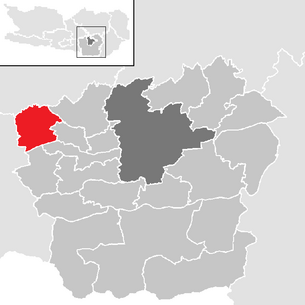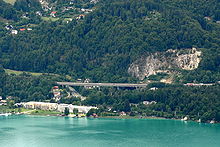Techelsberg am Wörther See
|
Techelsberg am Wörther See
|
||
|---|---|---|
| coat of arms | Austria map | |
|
|
||
| Basic data | ||
| Country: | Austria | |
| State : | Carinthia | |
| Political District : | Klagenfurt-Land | |
| License plate : | KL | |
| Main town : | St. Martin am Techelsberg | |
| Surface: | 28.37 km² | |
| Coordinates : | 46 ° 40 ′ N , 14 ° 6 ′ E | |
| Height : | 685 m above sea level A. | |
| Residents : | 2,178 (January 1, 2020) | |
| Population density : | 77 inhabitants per km² | |
| Postal code : | 9212 | |
| Area code : | 04272 | |
| Community code : | 2 04 35 | |
| NUTS region | AT211 | |
| Address of the municipal administration: |
Office building St. Martin 9212 Techelsberg |
|
| Website: | ||
| politics | ||
| Mayor : | Johann Koban ( ÖVP ) | |
|
Municipal Council : ( 2015 ) (19 members) |
||
| Location of Techelsberg am Wörther See in the Klagenfurt-Land district | ||
| Source: Municipal data from Statistics Austria | ||
geography
The municipality of Techelsberg extends over the southern slope of the Ossiacher Tauern to the north bank of the Wörthersee . With the Forstsee, another lake is part of the municipality.
Community structure
Techelsberg is divided into the four cadastral communities St. Bartlmä ( Šentjernej na Gori ), St. Martin am Techelsberg ( Šmartin ), Tibitsch ( Tibiče ) and Trabenig-Ebenfeld ( Trabenče ). The municipal area comprises 17 localities (with the respective autochthonous Slovenian equivalents according to Zdovc and the number of inhabitants in brackets as of January 1, 2020):
- Arndorf / Varpovče (178)
- Ebenfeld / Ravne (40)
- Greilitz / Skrilje (49)
- Hadanig / Hodanjče (74)
- Karl / Karov (43)
- Pavor / Pafor (48)
- Pernach / Podobje (66)
- Saag / Žaga (59)
- Sankt Bartlmä / Gora or Šentjernej na Gori (222)
- Sankt Martin am Techelsberg / Šmartin na Teholici (222)
- Schwarzendorf / Črnčiče (89)
- Sekull / Sekulče (399)
- Tibitsch / Tibiče (180)
- Töpriach / Toporje (103)
- Töschling / Došenče (240)
- Trabenig / Trabenče (37)
- Trieblach / Treblje (129)
Other districts are the Rotten Hasendorf , Haslitz and Poredia .
Neighboring communities
| Feldkirchen | ||
| Velden |

|
Moosburg |
| Schiefling on Lake Wörthersee |
Pörtschach Maria Wörth |
history
A Roman road ran in the area of the districts of Ebenfeld, Trabenig, Hadanig, Arndorf and Sankt Bartlmä .
The settlement Tohelach , which has been handed down since the middle of the 12th century , took the name of the patron saint of the parish church of St. Martin am Techelsberg in the late Middle Ages ; its first documentary mention comes from the year 1319. Today's branch church of St. Bartholomew in the village of St. Bartlmä was first mentioned in 1363. The Slovenian inscriptions from the baroque era are significant monuments of Slovenian local and national cultural history .
The parish of St. Martin coincided with the western part of the Leonstein district court until 1848, from which the local parish of St. Martin am Techelsberg was constituted in 1850. Apart from a re-suburb of 53 hectares to Velden in 1973, the area has remained constant to this day. The community name was changed in 1939 to "Techelsberg" and in 1968 the addition "am Wörther See" was added.
population
According to the 2001 census, Techelsberg am Wörther See has 2059 inhabitants, of which 96.2% have Austrian and 2.0% German citizenship . 83.1% of the population profess to the Roman Catholic and 5.0% to the Protestant Church , 8.3% describe themselves as non-denominational.
Culture and sights
Buildings
- The parish church of St. Martin in St. Martin am Techelsberg is slightly elevated in the north of the village. The originally Romanesque choir tower church was first mentioned in a document in 1319. Significant Baroque Slovenian inscriptions have been preserved in the church.
- The chaplain in Sankt Martin served the chaplain as an apartment. The last chaplain was hired in 1854. Today the chaplaincy is used for pastoral purposes. This house is built in log construction and can be estimated to be 500 years old. The chaplaincy was placed under monument protection on July 30, 2002 .
- The branch church of Saint Bartholomew in Sankt Bartlmä , which is surrounded by cemetery walls , was first mentioned in documents in 1363 and is a Gothic building with an easterly ridge turret.
- The subsidiary church of St. George in Tibitsch was first mentioned in 1616. The small baroque building is equipped with a retracted polygonal choir and an easterly turret. Significant Baroque Slovenian inscriptions have been preserved in the church.
- The branch church of Saint Vitus in Ebenfeld is a simple building from the 18th century with a Christophorus fresco on the southern outer wall of the ship
- The chapel of St. Joseph in Tibitsch is located in the forest east of the forest lake . It was built in 1958/59, has a steep gable roof and houses numerous votive pictures and carved figures from the 19th century.
- The Tschachonigkreuz on the eastern edge of Arndorf was erected around 1499. It is the largest niche shrine in Carinthia with a height of around 8 m and a tabernacle width of 2 m. Four large niches with representations of Saint Martin, Christ on the cross, Mary with the child, the mystery of the vine, angels and saints. The gable of the round roof is covered with spruce shingles, crowned by a star with the Christ monogram IHS. The precious wayside shrine was placed under special monument protection on February 17, 1993.
- The Forstsee power plant is a hydropower plant that went into operation in 1925 as the first storage power plant in Carinthia . The power house planned by Franz Baumgartner , which is located on the banks of Lake Wörthersee , has been a listed building since 1998 . The operator of the power plant is KELAG .
Marble quarry
In the past, the so-called Pörtschach marble was quarried, which is now exhausted. The quarry is still in operation and clearly visible from the southern motorway. Pörtschacher marble is white with pink streaks. This stone was used in many places in Klagenfurt, most notably in the Lendhafen . Since no identically patterned marble has been found anywhere in the world , objects made from Pörtschach marble achieve collector's prices in Klagenfurt.
At the western end of the former quarry there is now the Töschling climbing garden, which is also described in the climbing guide Climbing in Carinthia and East Tyrol .
Saager factory and lido
The former Miniumfabrik , which has been an important economic factor for the community since the 19th century, was shut down in the 1990s and currently functions as an event disco called “Die Fabrik” during the summer months . The most famous festival in July is the Fete Blanche , to which all visitors must appear dressed in white.
Opposite the factory there is the “Bad Sag” owned by SIG (Seeimmobiliengesellschaft). Swimming is also possible at the Forstsee , which can be reached from Saag via a road that leads up to Trabenig.
societies
- Techelsberg-Wörthersee singing circle since 1985
- The Techelsberg rural youth has existed since 1956.
- The Techelsberg theater group has been in existence since 1987. It was awarded the municipal coat of arms for its 2007 anniversary.
- The Techelsberg Customs Group has existed since 1995. In 2007 the association was awarded the golden Customs Pin.
- The Techelsberg Krampus Group has existed since 1976.
- The Techelsberg brass band was founded by Franz Uran in 1980. Kapellmeister (as of 2010) is Hirosh Nawa.
Economy and Infrastructure
The villages of Töschling and Sekull on the Wörthersee have now - even if compared to the neighboring communities Velden and Pörtschach very late - found connection to summer traffic, in the heavily wooded villages in the hinterland of the municipality, agriculture and forestry still dominate.
The Süd Autobahn (A 2) runs through the municipality ; the “Wörthersee” motorway service station, built in 2004, is located in the Techelsberg district. At the same time, Kärntner Straße (B 83) and the Klagenfurt - Villach railway line (Töschling station) run along the northern bank of the Wörthersee.
politics
Municipal council
The Techelsberg municipal council has 19 members and has been composed as follows since the 2015 municipal council election :
The directly elected mayor is Johann Koban (ÖVP).
coat of arms
The blue as the background of the Techelsberg coat of arms expresses the location on Lake Wörthersee, the three objects refer to the most famous resident of the community, the chronicler Jakob Unrest , who was appointed pastor in St. Stefan in 1466 and died here around 1500. The open book and the goose feather are symbols for the chronicler, whereby the goose feather is at the same time the attribute of the parish patron, St. Martin . The Turkish saber is a reminder of the devastating incursions of the Turks between 1473 and 1483 in Carinthia, which Unrest described in great detail as a contemporary witness.
The blazon of the coat of arms reads: "In blue a silver Turkish saber crossed diagonally with a silver goose feather, over it a silver open book."
The municipality's coat of arms and flag were awarded on May 29, 1989. The flag is blue and white with an incorporated coat of arms.
Personalities
- Jakob Unrest (* around 1430; † 1500), an important chronicler of the late Middle Ages, worked as a pastor in St. Martin am Techelsberg and died there too
- Anton Uran (1920–1943), conscientious objector and victim of the Nazi regime
literature
- Gertraud Warmuth, Tatjana Uran: Techelsberg am Wörther See . Self-published by the municipality of Techelsberg am Wörther See, Techelsberg 2004
Web links
- Techelsberg am Wörther See
- 20435 - Techelsberg am Wörther See. Community data, Statistics Austria .
Individual evidence
- ↑ Pavel Zdovc Slovenska krajevna imena na Koroškem Avstrijskem = Slovenian place names in Carinthia. Extended Edition. Ljubljana 2010. ISSN 0560-2920 .
- ↑ Statistics Austria: Population on January 1st, 2020 by locality (area status on January 1st, 2020) , ( CSV )
- ↑ Theodor Domej: Stenske slike s slovenskimi napisi v župnijski cerkvi v Šmartinu na Teholici. In: Koledar Mohorjeve družbe 1998. Celovec 1997, pages 108-110.
- ^ Dehio Kärnten , Verlag Anton Schroll & Co, Vienna 2001, ISBN 3-7031-0712-X , pp. 778, 952
- ^ Dehio Kärnten , Verlag Anton Schroll & Co, Vienna 2001, ISBN 3-7031-0712-X , p. 778.
- ↑ Theodor Domej: Stenske slike s slovenskimi napisi v župnijski cerkvi v Šmartinu na Teholici. In: Koledar Mohorjeve družbe 1998. Celovec 1997, pages 108-110.
- ^ Dehio Kärnten , Verlag Anton Schroll & Co, Vienna 2001, ISBN 3-7031-0712-X , p. 952.
- ↑ Theodor Domej: Stenske slike s slovenskimi napisi v župnijski cerkvi v Šmartinu na Teholici. In: Koledar Mohorjeve družbe 1998. Celovec 1997, pages 108-110.
- ↑ http://www.kleindenkmaeler.at/detail/tschachonig_kreuz
- ^ Ingo Neumann: Climbing in Carinthia and East Tyrol . Ed .: Ingo Neumann. Edition Neumann, Schiefling 2016, ISBN 978-3-901533-19-8 .
- ^ Quoted from Wilhelm Deuer: The Carinthian municipal coat of arms . Verlag des Kärntner Landesarchiv, Klagenfurt 2006, ISBN 3-900531-64-1 , p. 280.














